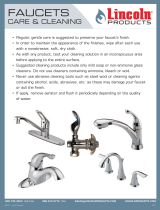
• Wear Proper Apparel--Loose-fitting or hanging
garments should never be worn while using the
appliance. Do not let clothing or other flammable
materials contact hot surfaces.
Never use your appliance for warming or
heating the room.
• Do Not Use Water or Flour on Grease Fires--Smother
the fire with a pan lid, or use baking soda, a dry
chemical or foam-type extinguisher.
• When heating fat or grease, watch it closely. Fat or
grease may catch fire if allowed to become too hot.
• Use Only Dry Pot holders--Moist or damp pot holders
on hot surfaces may result in burns from steam. Do not
let the pot holders touch the hot heating elements. Do not
use a towel or other bulky cloth instead of a pot holder.
• Do Not Heat Unopened Food Containers--Build-up of
pressure may cause the container to burst and result
in injury.
IMPORTANT--Do not attempt to operate the appliance
during a power failure. If power fails, always turn off the
appliance, if the appliance is not turned off and the power
resumes, it will begin to operate again. Once the power
resumes, reset the clock and oven function.
IMPORTANT INSTRUCTIONS FOR USING
YOUR OVEN
• Use Care When Opening an Oven Door--Stand to the
side of the appliance when opening the door of a hot oven.
Let hot air or steam escape before you remove or replace
food in the oven.
• Keep Oven Vent Ducts Unobstructed. The wall oven is
vented at the upper control panel or at the center trim
depending of the model. Touching the surfaces in this area
when the wall oven isoperating may cause severe burns.
Also, do not place plastic or heat-sensitive items near the
oven vent. These items could melt or ignite.
• Placement of Oven Racks. Always place oven racks in
desired location while oven is cool. Remove all utensils
from the rack before removing rack. If rack must be moved
while oven is hot, use extreme caution. Use pot holders
and grasp the rack with both hands to reposition. Do not let
pot holders contact the hot oven element or interior of the
oven.
• Do not use a broiler pan without its insert. The broiler
pan and grid allow dripping fat to drain and be kept away
from the high heat of the broiler.
• Do not cover broiler grid or oven bottom with
aluminum foil. Exposed fat and grease could ignite.
Do not touch a hot oven light bulb with a damp cloth.
Doing so could cause the bulb to break. Disconnect the
appliance or shut off the power to the appliance before
removing and replacing the bulb.
Protective liners--Do not use aluminum foil to line the
oven bottom. Only use aluminum foil as recommended in
this manual. Improper installation of these liners may
result in risk of electric shock, or fire.
IMPORTANT INSTRUCTIONS FOR CLEANING
YOUR OVEN
• Clean the appliance regularly to keep all parts free of
grease that could catch fire. Exhaust fan ventilation
hoods and grease filters should be kept clean. Do not
allow grease to accumulate. Greasy deposits in the fan
could catch fire. Refer to the hood manufacturer's
instructions for cleaning.
Cleaners/Aerosols--Always follow the manufacturer's
recommended directions for use. Be aware that excess
residue from cleaners and aerosols may ignite causing
damage and/or injury.
SELF=CLEANING OVEN MODELS
• Clean in the self-cleaning cycle only the parts of the
appliance listed in this Owner's Guide. Before using the
self-cleaning cycle of the appliance, remove all utensils
stored in the appliance.
• Do not clean the oven door gasket. The door gasket is
essential for a good seal. Care should be taken not to rub,
damage or move the gasket.
• Do not use oven cleaners. No oven cleaner or oven liner
protective coating of any kind should be used in or around
any part of the appliance
The health of some birds isextremely sensitive
to the fumes given off during the self-clean cycle of any wall
oven. Move birds to another well ventilated room.
IMPORTANT SAFETY NOTICE
The California Safe Drinking Water and Toxic
Enforcement Act requires the Governor of California to
publish a list of substances known to the state to cause
cancer, birth defects or other reproductive harm, and
requires businesses to warn customers of potential
exposure to such substances.
















